The PLA's short range SPAAML
The HQ-7 (For "Hongqi"-7 (hóng qí) meaning "red flag" or "red banner"), is the name of a ground-to-air AA short range missile developed in China from the French R-440 Crotale ("Rattlesnake") missile system. First developed with a 4x4 P20 carrier in the 1980s, it was further refined as the HQ-7A (1998) and then HQ-7B, carried by a new 6x6 vehicle, and exported as the FM-90. In 2009 the HQ-7B was deployed by the PLA in batteries of four HQ-7B vehicles, one with acquisition radar and three TELAR vehicles supported by a maintenance group with 10 support vehicles.Development
In the late 1970s after the death of Mao and the start of normalization of relations with the west, China started to import Western technologies in order to modernized its weapons systems, such as missiles. In this area, China purchased in France Crotale missiles in 1977 or 1978. This system, originally developed by Thomson CSF for South Africa in 1971 interested the French Army too, and became an export success, provided to 14 operators. Still in service, it went a long way, including onboard ships. Today, MDBA assumed development and export of the Crotale NG. South Korea developed its own SPAAML, the K-SAM Pegasus. The French R-440 was reverse-engineered and developed into the HQ-7 system by CPMIEC, later export to Iran as well. The first test firing of the projectile took place in 1985 and until 1988 it obtained its certification. The export version FM-80 was introduced in 1989 in the Dubai show. This weapon system is also called CSA-4 Sino-Crotale.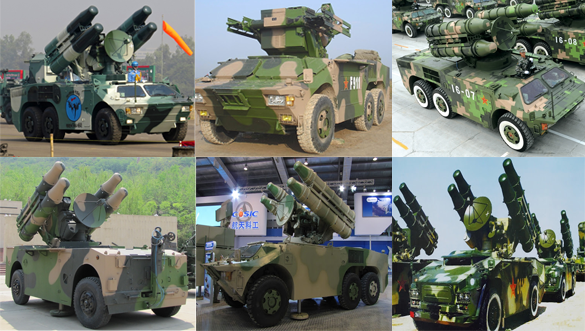
Various references from the web. Bottom, right, the 1989 4x4 P20 TELA (HQ-7/FM-80), and left, the towed point defence system
The carrier vehicle
France developed the Hotchkiss P-4R as part of a SPAAML battery composed of one radar vehicle for targeting acquisition and 2-3 launch vehicles with their own guiding system. The Chinese created a rather similar vehicle which was developed during the 1980s. The 4x4 vehicle name is not known, but placed under the same HQ-7 (FM-80), Self-Propelled designation. It was developed by the 206th Institute. It has not been exported. However it was probably found too slow and a more powerful vehicle, with better off-road characteristics was developed to carry the weapons system, including enough space for a complete reload. From the 1990s however, an improved version of the missile was developed, the FM-90 or HQ-7B, and the carrier 6x6 vehicle was upgraded as well. In 1998 it was presented by the China National Precision Machinery Import and Export Corporation (CNPMIEC). The other novelty for the missile was an IR-tracking camera. FM-90 is apparently the export designation. In 2020, China announced a replacement for this system called HQ-17 which was tested for the first time and is in service today, schedule to replace all SHORAD systems of the PRC. SrcAbout the HQ-7 missile system (FM-80)
Missile dimensions:- length - 3 m (9.8 ft) x diameter - 0.156 m (6.1 in) x wingspan - 0.55 m (1.8 ft)
- Launch weight: 84.5 kg (186 lb)
- Operating altitude: 30–5,000 m (98–16,404 ft)
- Minimum operating range: 500 m (HQ-7/FM-80)
- Max operating range: 8.6 km/400 m/s, 10 km/300 m/s, or 12 km
- Speed: Mach 2.3 (750 m/s)
- Guidance: Command + electro-optical tracking
- Warhead: HE-FRAG with proximity fuse
- Radar detecting range: 18.4 km
- Radar homing range: 17 km

A TELAR battery of the Bangladesh Air Force
Design of the 6x6 Hongqi Carrier
HQ-7/FM-80 B20 TELAR: The Hongqi-7 was first carried by a close of the French Thomson-Hotchkiss P-4R vehicle, a 4x4 vehicle propelled either by a diesel or gasoline engine, driving an alternator , powering in turn electrical motors which drive the wheels. It is small and cramped (no reloads for example for the missiles), with a small front driver position with no side visibility, the driver placed at the center, behind a three-windows structure and hatch above. The engine is located at the rear. The P-4R was cloned and renamed B20 in Chinese service, it is unarmed and lighlt armored (small arms fire and shrapnel).The 6x6 called HQ-7B/FM-90 is rather large, but use an upgraded version of the powerplant at the rear, a centrally-mounted HQ-7B turret with a four round elevating tube launcher, mounting the Ku-band Automatic Command to Line Of Sight (SACLOS) monopulse radar dish antenna. Both the export variant FM-80 and FM-90 had a FLIR tracker and the better HQ-7B missiles. These Batteries are typically supported by an acquisition radar system vehicle, in a ratio of 2-3 launcher for a tracker. The FM-90 vehicle is also 6 x 6 but quite different in appearance, notably for the front part which had a simplified nose and flat sides. We can guess it's a simplified export variant of the first vehicle. The vehicle is propelled by a diesel engine, approx. 400 hp, able to bring the vehicle to 90 kph on flat on an estimated range of around 600 km. For mibility, it has been estimated it could climb a gradient 60%, a side slope of 30%, vertical step of around 0.5 m, 0.6 m trench and ford 0.8 m of water.
The HQ-7B carried by the indigenous 6x6 armored chassis was first revealed circa 2009. The turret features apparently the same engagement radar to that of the previous HQ-7A (1998). The TELAR vehicle is operated by a crew of three and protrection is sufficient against small arms fire and artillery shell splinters. Mobility is much improved and it is globally more versatile than the original French Crotale/P4R system, rather as a point defense system. The Chilese TELAR however was designed to follow the infantry and mechanized units, so brining out mobility in the field. The radar displays a S-band Active Electronically Scanned Array (AESA) antenna.
The improved HQ-7B FM-90

The improved Bangladeshi HQ-7A on the early 6x6 vehicle (cc)

The improved Bangladeshi HQ-7B on its export carrier vehicle FM-90, 2017, by Shadman Chamee. Notice the new vehicle nose.
- Missile dimensions & weight: Same
- Operating altitude: 15–6,000 m (49–19,685 ft)
- Minimum operating range: 700 m
- Max operating range: 15 km for all targets)
- Speed: same
- Guidance, Warhead: Same
- Radar detecting range: 25 km
- Radar homing range: 20 km
Production & exports
China revealed the export version, FM-80, in the 1989 Dubai Air Show. Unit cost is around $162,000 per launcher and $24,500 per missile.Algeria: The Algerian Navy deployed it onboard C28A Class Corvette
Bangladesh: In the Air Force, Army and Navy
Pakistan: Army and Navy
Turkmenistan: In the Air Force.
The FM-80 (Feimeng 80) export version revealed in 1989 is not known to have been exported on the P20 chassis.
Iran developed the Shahab Tagheb, variant from this system, revealed in 1999 and developed with Chinese assistance and technology transfer.
HQ-7A improved variant was introduced in 1998, capable of 15 km, 25 km detection and tracking 20 km, the missile has a top speed of 900 m/s. The FM-90 (Feimeng 90) is the export version of this system HQ-7A. The HQ-7B was the first apparently based on the indigenous 6x6 armored chassis, revealed in 2009. Compared to the previous point-defence system it is truly mobile and can be integrated in an armoured or motorized unit of the PLAN. Mobility is only reduced by the fact the vehicle is not amphibious and too heavy to be ait-transported but by heavy lift planes which China lacks.
Operational use
The HQ-7 (FM-80) SAM is used both by the PLA and PLAAF (Air Force), both for short-range air-defense. In PLAAF bases, the HQ-7 is also deployed in fixed, hardened shelters while the PLA also operates it mounted on towed trailers.The typical land-based PLA HQ-7 battalion comprises three Operational Sections and a Support and Maintenance Section.
These Operational Sections comprises:
-A Search Unit E/F-band Doppler Search Radar (18.4 km range), a target processing unit (30 targets total, 12 simultaneously), a wired network to firing units and an IFF & radio section. -Three Firing Units, each with optical aiming system, four 40 kW generators, four to eight cell missile launcher, a J-band tracking radar (17 km range), a TV tracking system (15 km range), IR localiser, Target processing unit, Wired network and IFF & radio stations A Support & Maintenance Section comprises 10 support vehicles and a maintenance group.
Links
The HQ-7 on WikipediaThe FM-90 on Military-today
Wiki
The HQ-7B on ausairpower.net
The crotale on army-technology.com
Crotale: A Missile Defense System against Supersonic Low-Level Air Attack, International Defense Review 1/1970, Interavia S.A.
H. le Sueur, Design Philosophy of the Crotale AA System, International Defense Review - Air Defence Systems, Special Series, 1976, Interavia S.A.
Crotale in Service: organizational maintenance of a missile system, International Defense Review 2/1973, Interavia S.A.
CNPMIEC HQ-7 (FM-80) and FM-90 surface-to-air missile systems (China), Land systems Janes
HongQi 7 Surface-to-Air Missile System [online]. Sinodefence, rev. 2007-12-21.
NAVAL HQ-7 SHIP-TO-AIR MISSILE [online]. Sinodefence, rev. 2006-04-30.
CHANT, Chris. Válečné lodě současnosti. Praha: Deus, 2006.
PLZ-05 SPH specifications | |
| Dimensions | Unknown |
| Total weight, battle ready | Unknown |
| Crew | 3 (driver, commander, operator) |
| Propulsion | Unknown, possibly 8V150 turbocharged diesel, 800/1000 hp |
| Suspension | Unknown |
| Speed (road) | 90 km/h (50 mph) |
| Range | 600 km (approx.) |
| Armament | 4x Sino-Crotale Missile, HQ-7B system |
| Armor | Unknown |
| Total production | Unknown, circa 600 (current) |
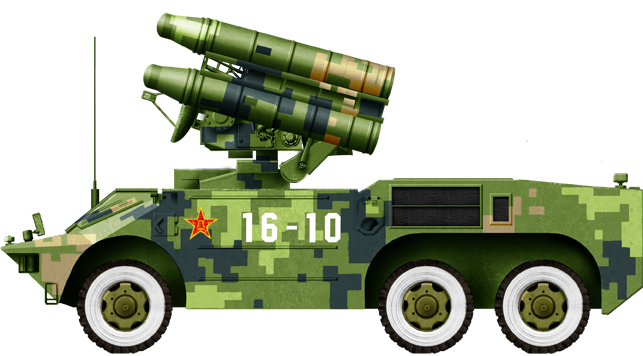
Hongqi HQ-7B FM-90 as shown in a 2015 military parade in beijing, with parade tyres and digital summer camouflage.
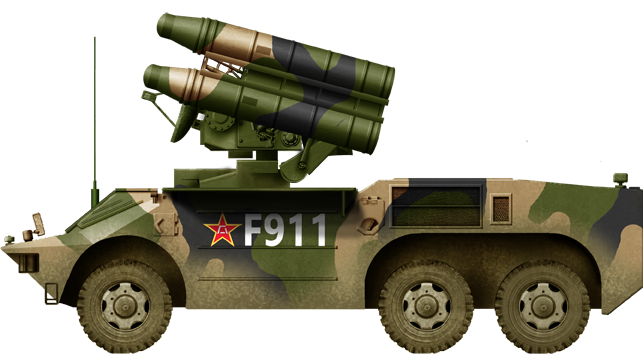
FM-90 6x6 vehicle in standard camouflage in manoeuvers in the 1990s.
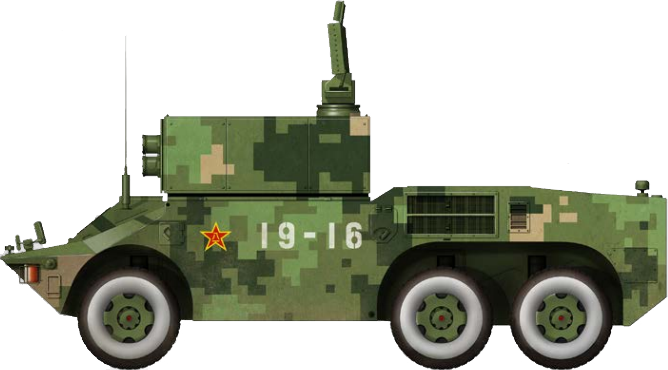
A TAS (Radar Tracking) battery vehicle. The FM-90 acquisition radar uses a mechanically steered S-band 3D, and an Active Electronically Scanned Array (AESA) antenna. It can detect 48 target and track 24 of them simultaneous. (ak interactive).
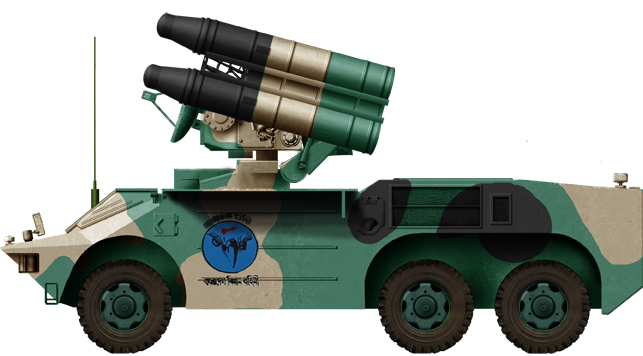
Bangladeshi FM-90 HQ-7A during a parade

Modern Tanks
Modern MBTs posters

Denel Bagder (2018)

Type 16 MCV (2016)

Gepard 1A2 last rounds 2011

SANDF

Russian AFVs

Main Battle Tanks

